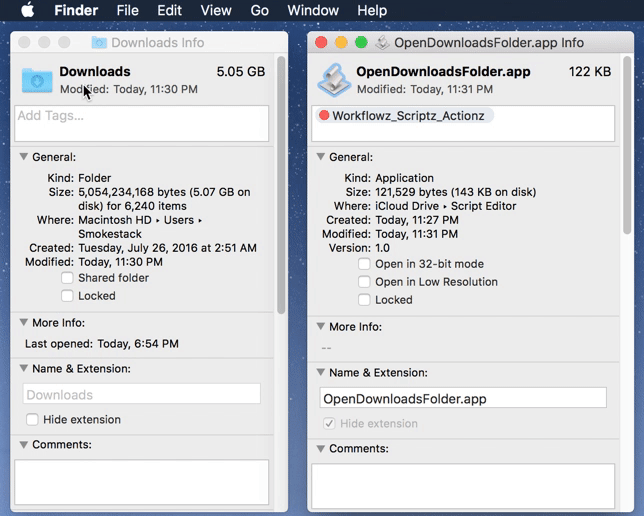Un altro modo per ottenere ciò che stai chiedendo, fatto anche come applicazione AppleScript, ma in grado di personalizzare le proprietà della finestra.
In Script Editor, crea un nuovo documento e aggiungi il seguente code AppleScript come esempio:
set theTarget to (path to downloads folder as string)
tell application "Finder"
set theWindow to make new Finder window to folder theTarget
tell theWindow to set {current view, toolbar visible, bounds} to {list view, true, {0, 23, 1024, 512}}
activate
end tell
Puoi modificare le proprietà a tuo piacimento nella riga tell theWindow to set di codice in base alle proprietà disponibili.
Per ottenere le proprietà, puoi aprire una finestra del Finder nella cartella dei download, sistemarla come vorresti apparire ogni volta e poi usare quanto segue in un documento AppleScript separato per ottenere le proprietà da usare nell'app che lo apre:
tell application "Finder" to get properties of windows "Downloads"
Il comando precedente restituisce il seguente esempio di output:
{class:Finder window, id:1004, name:"Downloads", position:{0, 23},
bounds:{0, 23, 1024, 512}, index:1, zoomed:false, closeable:true,
titled:true, floating:false, modal:false, resizable:true,
zoomable:true, visible:true, collapsed:false, target:folder
"Downloads" of folder "me" of folder "Users" of startup disk of
application "Finder", current view:list view, icon view options:icon
view options of Finder window id 1004 of application "Finder", list
view options:list view options of Finder window id 1004 of application
"Finder", column view options:column view options of Finder window id
1004 of application "Finder", toolbar visible:true, statusbar
visible:true, sidebar width:213}
In questo modo, ottieni una nuova finestra del Finder aperta nella cartella Download impostata esattamente come desideri, in base alle proprietà disponibili.
Vedi la risposta di wch1zpink per assegnare l'icona della cartella Download all'icona dell'applicazione AppleScript.
